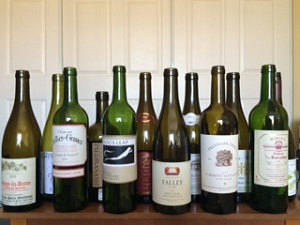 Because we go back-and-forth between North Carolina and California our wine drinking changes between “New World” California wines (when we are in California) and “Old World” European wines (when we’re in North Carolina). So this year we decided to take the bull by the horns and see what would come from blind tasting similar priced wines made with the same grapes, but from California and Europe…sort of our own “Judgement of Pairs” mini-tasting. For our test we brought six bottles of European Old World wines, purchased from the Caviste Wine Store in Winston-Salem, North Carolina, when we traveled to California. The New World wines were purchased from the Woodland Hills Wine Company in Woodland Hills, California. For our blind tasting we included grape varieties that were commonly grown in both Europe and California and included: Pinot Noir, Merlot, Chardonnay, Cabernet Sauvignon, Syrah and Cabernet Franc and we made every attempt to buy wines that were close to the same price. We did the tasting one grape variety at a time over a period of two weeks. The bottles were opened and covered than marked “A” and “B” by another person, so no one knew which wine we were drinking. Each taster had two glasses (marked A and B) and had to select which they liked “Best” and identify the one they thought contained the Old World and New World wine. The tasters included Vicky and myself, our son and daughter-in-law (who drink predominately California red wines) and the Portuguese cinematographer who is working on a film (see The Pinch) with our son. The results were surprising and very interesting, but first here’s the result of the individual tasting:
Because we go back-and-forth between North Carolina and California our wine drinking changes between “New World” California wines (when we are in California) and “Old World” European wines (when we’re in North Carolina). So this year we decided to take the bull by the horns and see what would come from blind tasting similar priced wines made with the same grapes, but from California and Europe…sort of our own “Judgement of Pairs” mini-tasting. For our test we brought six bottles of European Old World wines, purchased from the Caviste Wine Store in Winston-Salem, North Carolina, when we traveled to California. The New World wines were purchased from the Woodland Hills Wine Company in Woodland Hills, California. For our blind tasting we included grape varieties that were commonly grown in both Europe and California and included: Pinot Noir, Merlot, Chardonnay, Cabernet Sauvignon, Syrah and Cabernet Franc and we made every attempt to buy wines that were close to the same price. We did the tasting one grape variety at a time over a period of two weeks. The bottles were opened and covered than marked “A” and “B” by another person, so no one knew which wine we were drinking. Each taster had two glasses (marked A and B) and had to select which they liked “Best” and identify the one they thought contained the Old World and New World wine. The tasters included Vicky and myself, our son and daughter-in-law (who drink predominately California red wines) and the Portuguese cinematographer who is working on a film (see The Pinch) with our son. The results were surprising and very interesting, but first here’s the result of the individual tasting:
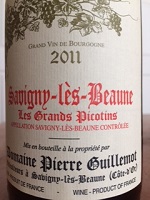 |
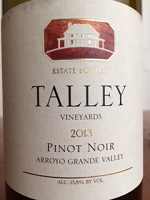 |
1. Pinot Noir: The first tasting included Talley Vineyards Arroyo Grande Valley Pinot Noir 2013, $31.951. and; Domaine Pierre Guillemot Savigny-lès-Beaune Les Grands Picotins 2011, $30.602.. Both were excellent wines and outstanding pairings with the grilled pork loin dinner, but the Talley had more going on in bouquet (fruit, smoke and earthiness), more complex flavors and a noteworthy finish. In the end three of the four tasters said they liked the Talley best, but were equally divided when identifying which was the Old World and New World wine.
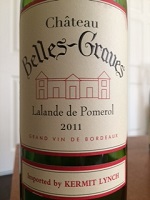 |
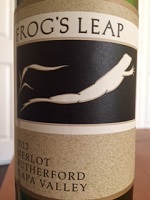 |
2. Merlot: The wines for the Merlot tasting were Chateau Belles-Graves Lalande de Pomerol 2011, $30.602. (88% Merlot) and Frog’s Leap Rutherford Napa Valley Merlot 2013 $34.951. (82% Merlot). The big surprise with this tasting was the similarity of the two wines. Both were paired well with rosemary/roast chicken and even drinking alone it took careful tasting to pick out the differences. It was the mid-palate taste and the finish that separated one from the other. The Belles-Graves had a rich earthiness, more velvety tannins and fresher fruit flavors in the finish. They were almost exactly the same alcohol content and opened 30-minutes before drinking, but the Frog’s Leap had hints of alcohol right through the last pour (it clearly would have benefited from decanting) while the Belles-Graves had none. In the end all four tasters liked the Chateau Belle-Graves best; but only three of the four selected the correct Old World bottle.
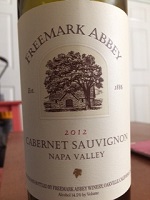 |
 |
3. Cabernet Sauvignon: This tasting included two VERY different wines that set the stage for fast easy decisions for everyone. These wines were Chateau les Barraillots Margaux Cru Artisan 2012 $30.602. and Freemark Abbey Napa Valley Cabernet Sauvignon 2012 $34.951.. The Chateau les Barraillots was simply delicious, rich, full-bodied, filled with flavors, smooth tannins and an OUTSTANDING pairing with the beef brisket, while the Fremark Abbey was an easy drinking fruity wine. All five tasters liked the Chateau les Barraillots best but only two of them identified it correctly as the Old World wine.
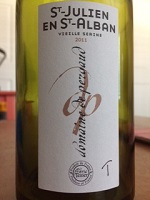 |
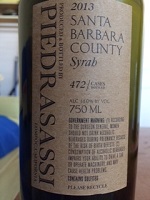 |
4. Syrah: For the Syrah tasting we paired barbecued chicken with Piedrasassi Santa Barbara County Syrah 2013 $34.951. and Domaine de Pergaud St Julien en St Alban Vieille Serine 2011 $32.402.. This was one of the best tastings because the the wines were dramatically different. The Domaine de Pergaud was FANTASTIC classic Rhone Syrah while the Piedrasassi (which was recommended by the wine store as an Old World tasting Syrah) simply couldn’t compete. Four of the five tasters liked the Domaine de Pergaud best but a different four of the five were able to identify it as the Old World wine.
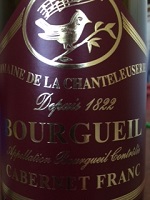 |
 |
5. Cabenet Franc: The Cabernet Franc tasting included Domaine de la Chanteleuserie Bourgueil 2015 $14.402. and a Hawkes Bay, New Zealand Pyramid Valley vineyards Howell Family Vineyard 2012 $19.881.. We threw a slight curve into this tasting by having a New Zealand New World Cab Franc and it provided a comparison of two wines that were very different. Although they both had the characteristic Cab Franc taste the the Domaine de la Chanteleuserie had rich aromas and outstanding depth for a wine only costing $14.40 and with the roast pork it was simply DELICIOUS!!! All five tasters liked the Domaine de la Chateleuserie best but only three of the five were able to identify it correctly as the Old World wine.
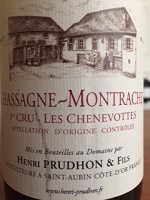 |
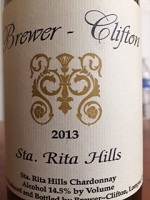 |
6. Chardonnay: For the Chardonnay tasting we paired Henri Prudhon & Fils Chassagne-Montrachet 1er Cru Les Chenevottes 2012 $30.602. and Brewer-Clifton Santa Rita Hills Chardonnay 2013 $31.952. with grilled salmon. Everyone recognized the difference in these wines and four of the five tasters liked the Henri Prudhon & Fils best. With its mineral aromas, rich fruit and long delicate flavors it could only be described as OUTSTANDING. The Brewer-Clifton Chardonnay was succulent and delicious, but clearly had the characteristic oak and vanilla taste of California Chardonnay. In the end all five tasters identified the Old World Chardonnay correctly.
Results: What’s the “real” difference between an Old World and New World wine? In our non-statistical and fun side-by-side blind tasting of six grape varieties we found that tasters frequently agreed on which wine they liked best, but, when identifying which was the New World and the Old World wine there was not much accuracy…only the Chardonnay was correctly identified by all the tasters. But, possibly the most interesting result was (with the exception of the Pinot Noir)…most people liked the Old World wine best.
The great part of this blind tasting format was everyone became involved and contributed to the discussion while trying to guess which bottle held the Old World wine. In the end everyone came away with a better appreciation of the difference between an Old World and a New World wine. And, even though every palate is a little different it was surprising to see how frequently everyone selected the same wine as their choice for the best one.
Having tried it, we would say having your own Judgement of Paris tasting provides a great format for a wine tasting party. There are enough varieties of grapes that are grown in both regions to pair with almost any food, it works equally well with any price wines, it’s compatible with any level of wine tasting experience, and it really provides an opportunity for every wine taster to be actively involved in the fun. And, if you really think this is to easy, just include some of the Central Coast California Rhone wines and it will really separate the men from the boys. No matter how you do it, this is simply a great theme for a wine tasting party…we guarantee it!!!
Purchased from:
1. Woodland Hills Wine Company; Woodland Hills, California.
2. The Caviste Wine Shop; Winston-Salem, North Carolina.